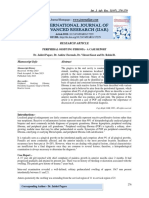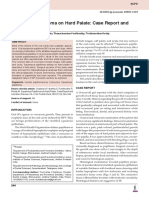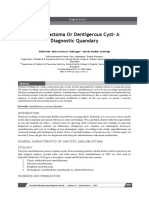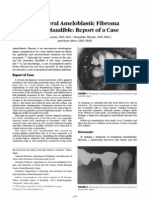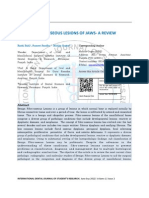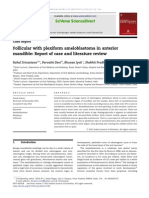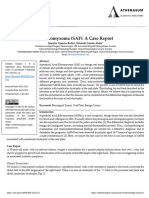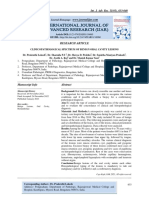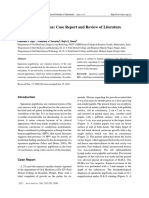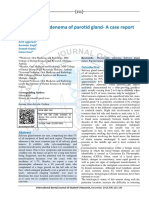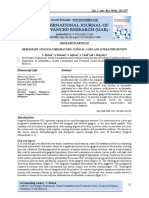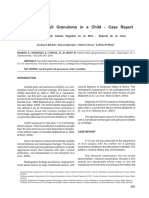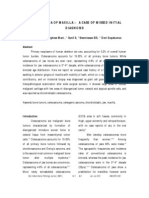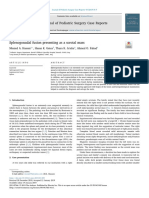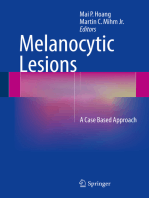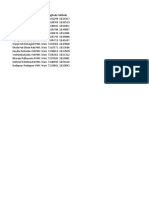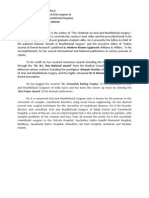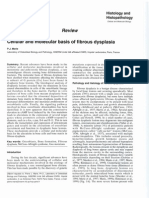Clinical: Peripheral Ossifying Fibroma: A Case Report
Clinical: Peripheral Ossifying Fibroma: A Case Report
Uploaded by
sagarjangam123Copyright:
Available Formats
Clinical: Peripheral Ossifying Fibroma: A Case Report
Clinical: Peripheral Ossifying Fibroma: A Case Report
Uploaded by
sagarjangam123Original Description:
Original Title
Copyright
Available Formats
Share this document
Did you find this document useful?
Is this content inappropriate?
Copyright:
Available Formats
Clinical: Peripheral Ossifying Fibroma: A Case Report
Clinical: Peripheral Ossifying Fibroma: A Case Report
Uploaded by
sagarjangam123Copyright:
Available Formats
Clinical
Practice
Peripheral Ossifying Fibroma: A Case Report
Terry Farquhar, RN, DDS; Jennifer MacLellan, BSc, MSc, DDS, Cert Ped, FRCD(C); Heather Dyment, DDS, Dip Ped, FRCD(C); Ross D. Anderson, DDS, Dip Paed, MSc, FRCD(C)
Contact Author
Dr. Farquhar Email: terry_farquhar@ urmc.rochester.edu
ABSTRACT
This article describes a case of peripheral ossifying fibroma in a 12-year-old girl. Clinical, radiographic and histologic characteristics are discussed and recommendations regarding differential diagnosis, treatment and follow-up are provided. The importance of excellent communication with patients is emphasized.
For citation purposes, the electronic version is the definitive version of this article: www.cda-adc.ca/jcda/vol-74/issue-9/809.html
any types of localized reactive lesions may occur on the gingiva, including focal fibrous hyperplasia, pyogenic granuloma, peripheral giant cell granuloma and peripheral ossifying fibroma (POF).13 These lesions may arise as a result of such irritants as trauma, microorganisms, plaque, calculus, restorations and dental appliances.2,3 The purpose of this article is to present a case of POF, briefly review the current literature on this condition and emphasize the importance of discussion of a reasonable differential diagnosis with the patient or a parent. Case Report A healthy 12-year-old girl presented to the pediatric dental unit at the IWK Health Centre with a lump behind her front teeth. She had been referred by her physician to the ear, nose and throat department, but was subsequently referred to the pediatric dentistry department. According to the patient, the reddish purple lump had been present for approximately 4 months and her mother stated that it had just recently become visible between the front teeth. As reported by the patient, the lump was interfering with her bite and
felt uncomfortable, similar to a canker sore. Occasionally, bleeding occurred when she brushed her teeth. During the consultation, it became apparent that the patients mother was very concerned about the pathogenesis of the lesion. According to the mother, their family physician had discussed the possibility of the lesion being a carcinoma. This had raised the mothers anxiety level considerably. Clinical Examination Clinical examination revealed an erythematous maxillary central papilla visible from the facial aspect (Fig. 1). Palatally, the lesion appeared exophytic and nodular with an irregular surface (Fig. 2). It measured approximately 10 mm laterally, 8 mm in the anteriorposterior direction and 6 mm thick. It extended from 2 mm to the left of the palatal midline to 8 mm to the right of the midline. The lesion appeared reddish-pink with areas of white. It was slightly pedunculated with what appeared to be a broad-based attachment. The lesion was not fluctuant, nor did it blanch with pressure, but had a rubbery consistency. It was tender to firm pressure, but not to light palpation.
809
JCDA www.cda-adc.ca/jcda November 2008, Vol. 74, No. 9
Farquhar
Figure 1: Facial view of an erythematous maxillary papilla just visible below incisors.
Figure 2: Palatal view of the lesion.
Figure 3: Maxillary occlusal radiograph showing normal aspect.
Radiographic Examination Panoramic and maxillary occlusal radiographs were obtained. The radiographic examination was within normal limits, with no findings pertaining to the maxillary exophytic lesion (Fig. 3). Diagnosis The differential diagnosis consisted of irritation fibroma, pyogenic granuloma and peripheral giant cell granuloma (PGCG). This differential diagnosis was discussed with the patient and her mother in an attempt to alleviate fears of squamous cell carcinoma. Treatment Under general anesthesia, the lump was excised completely using both a scalpel and an electrocautery device. The removed tissue and adjacent periosteum measured 15 mm 15 mm 3 mm. The tissue was submitted to the oral pathology division for histopathologic diagnosis. Adjacent teeth were scaled to remove any local irritants. Microscopic examination of the excised tissue revealed a gingival nodule that was partly ulcerated and partly lined with hyperparakeratinized stratified squamous epithelium with a normal maturation pattern. Much of the nodule consisted of hypercellular, well-vascularized fibrous connective tissue containing plump mesenchymal cells as well as numerous multinucleated giant cells. The specimen also exhibited a fairly large area of immature bone formation but no evidence of malignancy. The histopathologic diagnosis was peripheral cemento-ossifying fibroma. The oral pathologist was contacted by the author to confirm that the terms POF and peripheral cemento-ossifying fibroma could be used interchangeably. The pathology report stated that por810
tions of the fibroma showed typical areas of pyogenic granuloma as well as smaller areas of PGCG. Follow-up The patient presented for a follow-up examination 20 days postoperatively. The surgical site appeared to be healing well (Fig. 4). There was no evidence of recurrence of the lesion, and the child was asymptomatic. Discussion Intraoral ossifying fibromas have been described in the literature since the late 1940s. Many names have been given to similar lesions, such as epulis,1 peripheral fibroma with calcification,1 peripheral ossifying fibroma, 2,3 calcifying fibroblastic granuloma,4 peripheral cementifying fibroma, peripheral fibroma with cementogenesis5 and peripheral cemento-ossifying fibroma.6 The sheer number of names used for fibroblastic gingival lesions indicates that there is much controversy surrounding the classification of these lesions. 5,7 It has been suggested that the POF represents a separate clinical entity rather than a transitional form of pyogenic granuloma, PGCG or irritation fibroma.1 Eversole and Rovin 2 stated that, with the similar sex and site predilection of pyogenic granuloma, PGCG and POF, as well as similar clinical and histologic features, these lesions may simply be varied histologic responses to irritation. Gardner3 stated that POF cellular connective tissue is so characteristic that a histologic diagnosis can be made with confidence, regardless of the presence or absence of calcification. Buchner and Hansen8 hypothesized that early POF presents as ulcerated nodules with little calcification, allowing easy misdiagnosis as a pyogenic granuloma. Several publications2,3,79 address the issue of
JCDA www.cda-adc.ca/jcda November 2008, Vol. 74, No. 9
Peripheral Ossifying Fibroma
Figure 4: Palatal view of surgical site showing satisfactory healing 20 days after surgery.
histologic differentiation in depth, but this is beyond the scope of this article. When presented clinically with a gingival lesion, it is important to establish a differential diagnosis. In this case, the clinical features led to a differential diagnosis of irritation fibroma, pyogenic granuloma or PGCG. Although it is also important to maintain a high index of suspicion, discussion with family members should be tactful to prevent undue distress during the waiting period between differential diagnosis and definitive histopathologic diagnosis. Because the clinical appearance of these various lesions can be remarkably similar, classification is based on their distinct histologic differences. The POF must be differentiated from the peripheral odontogenic fibroma (PODF) described by the World Health Organization. 3,8 Histologically, the PODF has been defined as a fibroblastic neoplasm containing odontogenic epithelium.9 Despite a preponderance of literature supporting differentiation, some authors continue to argue that the POF (or peripheral cemento-ossifying fibroma) is the peripheral counterpart of the central cemento-ossifying fibroma.6 The POF, as discovered in this case, is a focal, reactive, non-neoplastic tumour-like growth of soft tissue often arising from the interdental papilla.1,3 It is a fairly common lesion, comprising nearly 3% of oral lesions biopsied in 1 study,1 approximately 1%2% in other studies.911 In 1993, Das and Das12 obtained similar results, with 1.6% POFs among 2,370 intraoral biopsies. POF may present as a pedunculated nodule, or it may have a broad attachment base.1,11,13 These lesions can be red to pink with areas of ulceration, and their surface may be smooth or irregular. Although they are generally < 2 cm in diameter, 8,13 size can vary; reports range from
0.23.0 cm8,11 to 4 mm8 cm1,14 and some lesions may be as large as 9 cm in diameter.15 Cases of tooth migration and bone destruction have been reported, but these are not common.15 The female to male ratio reported in the literature varies from 1.22:116 and 1.7:1810 to 4.3:1.2 By most reports, the majority of the lesions occur in the second decade, with a declining incidence in later years.1,2,810 There are 2 reported cases of POF present at birth, presenting clinically as congenital epuli.17,18 In a 2001 study, Cuisia and Brannon11 reported that only 134 out of 657 diagnosed POFs (20%) were in the pediatric population (019 years), with 8% in the first decade. In a retrospective study of 431 cases in the Chinese population by Zhang and others,16 the mean age of incidence of POF was found to be 44 years, which is contradictory to previously published literature. POF appears to be more common among white people than black11 and slightly less common among those of Hispanic origin.12 The lesion may be present for a number of months to years before excision, depending on the degree of ulceration, discomfort and interference with function.1,8 Approximately 60% of POFs occur in the maxilla, 8,9,16 and they occur more often in the anterior than the posterior area,9,12,16 with 55%60% presenting in the incisor-cuspid region.1,2,8,11,16 POFs are believed to arise from gingival fibres of the periodontal ligament as hyperplastic growth of tissue that is unique to the gingival mucosa.13,19 This hypothesis is based on the fact that POFs arise exclusively on the gingiva, the subsequent proximity of the gingiva to the periodontal ligament and the inverse correlation between age distribution of patients presenting with POF and the number of missing teeth with associated periodontal ligament.9,11,19 In a study of 134 pediatric patients with POF,11 in only 2 cases was POF intimately associated with primary teeth, bringing into question the reactivity of the lesion. The exfoliation of primary teeth and eruption of their successors should result in an increased incidence of periodontal ligament-associated reactive lesions. 2,11 Hormonal influences may play a role, given the higher incidence of POF among females, increasing occurrence in the second decade and declining incidence after the third decade.9 In an isolated case of multicentric POF, Kumar and others5 noted the presence of a lesion at an edentulous site in a 49-year-old woman, which once again raises questions regarding the pathogenesis of this type of lesion. Histologically, the POF appears to be a nonencapsulated mass of cellular fibroblastic connective tissue3 of mesenchymal origin, covered with stratified squamous epithelium, which is ulcerated in 23%66% of cases.1,8 Most ulcerated lesions occur in patients in the second decade.2,8 POFs contain areas of fibrous connective tissue, endothelial proliferation and mineralization. Endothelial
811
JCDA www.cda-adc.ca/jcda November 2008, Vol. 74, No. 9
Farquhar
proliferation can be profuse in the areas of ulceration, which can be misleading in clinical diagnosis, as the lesion may appear to be a pyogenic granuloma.1 The mineralized component of POF varies, occurring in approximately 23%,16 35%9 or 50%75%1,7,8 of cases according to published reports. Mineralization can vary between cementum-like material, bone (woven and lamellar) and dystrophic calcification.1,7,8 The POF lesion is generally small and does not require imaging beyond radiographs. 3,20 Treatment consists of conservative surgical excision1,9 and scaling of adjacent teeth. 3 The rate of recurrence has been reported at 8.9%,1 9%,11 14%,9 16%8 and 20%.2 Therefore, regular follow-up is required. Conclusions POF is a slowly progressing lesion, the growth of which is generally limited. Many cases will progress for long periods before patients seek treatment because of the lack of symptoms associated with the lesion. A slowly growing pink soft tissue nodule in the anterior maxilla of an adolescent should raise suspicion of a POF. Discussion of the differential diagnosis should be done tactfully to prevent unnecessary distress to the patient and family. Zhang and others16 noted that cancer was included in the differential diagnosis in only 2% of cases. In the current case, the family experienced distress related to the suggestion of squamous cell carcinoma before referral for treatment and definitive diagnosis. Treatment consists of surgical excision, including the periosteum, and scaling of adjacent teeth. Close postoperative follow-up is required because of the growth potential of incompletely removed lesions and the 8%20% recurrence rate. a THE AUTHORS
Dr. Farquhar is a pediatric dental resident at the Eastman Dental Center, University of Rochester, New York.
References
1. Bhaskar SN, Jacoway JR. Peripheral fibroma and peripheral fibroma with calcification: report of 376 cases. J Am Dent Assoc 1966; 73(6):131220. 2. Eversole LR, Rovin S. Reactive lesions of the gingiva. J Oral Pathol 1972; 1(1):308. 3. Gardner DG. The peripheral odontogenic fibroma: an attempt at clarification. Oral Surg Oral Med Oral Pathol 1982; 54(1):408. 4. Lee KW. The fibrous epulis and related lesions. Granuloma pyogenicum, Pregnancy tumour, fibro-epithelial polyp and calcifying fibroblastic granuloma. A clinico-pathological study. Periodontics 1968; 6(6):27792. 5. Kumar SK, Ram S, Jorgensen MG, Shuler CF, Sedghizadeh PP. Multicentric peripheral ossifying fibroma. J Oral Sci 2006; 48(4):23943. 6. Feller L, Buskin A, Raubenheimer EJ. Cemento-ossifying fibroma: case report and review of the literature. J Int Acad Periodontol 2004; 6(4):1315. 7. Zain RB, Fei YJ. Fibrous lesions of the gingiva: a histopathologic analysis of 204 cases. Oral Surg Oral Med Oral Pathol 1990; 70(4):46670. 8. Buchner A, Hansen LS. The histomorphologic spectrum of peripheral ossifying fibroma. Oral Surg Oral Med Oral Pathol 1987; 63(4):45261. 9. Kenney JN, Kaugars GE, Abbey LM. Comparison between the peripheral ossifying fibroma and peripheral odontogenic fibroma. J Oral Maxillofac Surg 1989; 47(4):37882. 10. Skinner RL, Davenport WD Jr, Weir JC, Carr RF. A survey of biopsied oral lesions in pediatric dental patients. Pediatr Dent 1986; 8(3):1637. 11. Cuisia ZE, Brannon RB. Peripheral ossifying fibroma a clinical evaluation of 134 pediatric cases. Pediatr Dent 2001; 23(3):2458. 12. Das S, Das AK. A review of pediatric oral biopsies from a surgical pathology service in a dental school. Pediatr Dent 1993; 15(3):20811. 13. Neville BW, Damm DD, Allen CM, Bouquot JE. Oral and maxillofacial pathology. 2nd ed. Philadelphia: WB Saunders Co; 2002. p. 4512. 14. Bodner L, Dayan D. Growth potential of peripheral ossifying fibroma. J Clin Periodontol 1987; 14(9):5514. 15. Poon CK, Kwan PC, Chao SY. Giant peripheral ossifying fibroma of the maxilla: report of a case. J Oral Maxillofac Surg 1995; 53(6):6958. 16. Zhang W, Chen Y, An Z, Geng N, Bao D. Reactive gingival lesions: a retrospective study of 2,439 cases. Quintessence Int 2007; 38(2):10310. 17. Yip WK, Yeow CS. A congenital peripheral ossifying fibroma. Oral Surg Oral Med Oral Pathol 1973; 35(5):6616. 18. Kohli K, Christian A, Howell R. Peripheral ossifying fibroma associated with a neonatal tooth: case report. Pediatr Dent 1998; 20(7):4289. 19. Miller CS, Henry RG, Damm DD. Proliferative mass found in the gingiva. J Am Dent Assoc 1990; 121(4):55960. 20. Moon WJ, Choi SY, Chung EC, Kwon KH, Chae SW. Peripheral ossifying fibroma in the oral cavity: CT and MR findings. Dentomaxillofac Radiol 2007; 36(3):1802.
Dr. MacLellan is an assistant professor in pediatric dentistry, faculty of dentistry, Dalhousie University, Halifax, Nova Scotia. Dr. Dyment is an assistant professor in pediatric dentistry, faculty of dentistry, Dalhousie University, Halifax, Nova Scotia. Dr. Anderson is the chief of dentistry, IWK Health Centre, Halifax, an assistant professor and division head, pediatric dentistry, faculty of dentistry, Dalhousie University, Halifax, Nova Scotia. Correspondence to: Dr. Terry Farquhar, Eastman Dental Center/ University of Rochester, 625 Elmwood Avenue, Rochester, NY 14620. The authors have no declared financial interests. This article has been peer reviewed.
812 JCDA www.cda-adc.ca/jcda November 2008, Vol. 74, No. 9
You might also like
- Case of OsteosarcomaDocument25 pagesCase of Osteosarcomadocs2009100% (3)
- Absent Father Effects ResearchDocument14 pagesAbsent Father Effects ResearchRaymond LeeNo ratings yet
- Quiz On School Health NursingDocument7 pagesQuiz On School Health Nursingchoobi33% (3)
- Benefits of A Healthy Eating PlanDocument2 pagesBenefits of A Healthy Eating PlanAbhishek GuptaNo ratings yet
- FOP MulticentricoDocument5 pagesFOP MulticentricoLeticia Sant'Anna TeixeiraNo ratings yet
- Ameloblastic Fibroma: Report of A Case: Su-Gwan Kim, DDS, PHD, and Hyun-Seon Jang, DDS, PHDDocument3 pagesAmeloblastic Fibroma: Report of A Case: Su-Gwan Kim, DDS, PHD, and Hyun-Seon Jang, DDS, PHDdoktergigikoeNo ratings yet
- Pulpitis JurnalDocument2 pagesPulpitis JurnalIsmail YusufNo ratings yet
- Brown Tumors of The Oral Cavity: Presentation of 4 New Cases and A Systematic Literature ReviewDocument14 pagesBrown Tumors of The Oral Cavity: Presentation of 4 New Cases and A Systematic Literature Reviewisma wahyuniNo ratings yet
- Pof CR4Document5 pagesPof CR4Swab IndonesiaNo ratings yet
- Peripheral Ossifying Fibroma: A Case ReportDocument3 pagesPeripheral Ossifying Fibroma: A Case ReportIJAR JOURNALNo ratings yet
- Lobular Capillary Hemangioma of TongueDocument3 pagesLobular Capillary Hemangioma of TongueShreya DasguptaNo ratings yet
- Peripheral Ossifying Fibroma - A Case ReportDocument4 pagesPeripheral Ossifying Fibroma - A Case ReportIJAR JOURNALNo ratings yet
- Giant Cell Epulis: Report of 2 Cases.: Oral PathologyDocument11 pagesGiant Cell Epulis: Report of 2 Cases.: Oral PathologyVheen Dee DeeNo ratings yet
- Squamous Papilloma On Hard Palate: Case Report and Literature ReviewDocument3 pagesSquamous Papilloma On Hard Palate: Case Report and Literature ReviewadelNo ratings yet
- Is Bleeding On Probing A Differential Diagnosis Between Periimplant Health and Disease?Document5 pagesIs Bleeding On Probing A Differential Diagnosis Between Periimplant Health and Disease?Tonya GoldenNo ratings yet
- Case Report: DiscussionDocument2 pagesCase Report: DiscussionAlfonsius JeriNo ratings yet
- AdsfDocument7 pagesAdsfNarito NianNo ratings yet
- Gingival Epulis: Report of Two Cases.: Dr. Praful Choudhari, Dr. Praneeta KambleDocument5 pagesGingival Epulis: Report of Two Cases.: Dr. Praful Choudhari, Dr. Praneeta KambleAnandNo ratings yet
- Osseous Choristoma of The Periodontium: Case ReportDocument3 pagesOsseous Choristoma of The Periodontium: Case ReportAndykaYayanSetiawanNo ratings yet
- JPNR - S04 - 233Document6 pagesJPNR - S04 - 233Ferisa paraswatiNo ratings yet
- BrazJOralSci 2007 Vol6 Issue21 p1364Document3 pagesBrazJOralSci 2007 Vol6 Issue21 p1364Inesza Sylviane AndariNo ratings yet
- Bone Tumors of Childhood - A Comparative Review of The TypesDocument10 pagesBone Tumors of Childhood - A Comparative Review of The TypesnjczftzdchNo ratings yet
- Literature Review OsteosarcomaDocument8 pagesLiterature Review Osteosarcomaea813c29100% (1)
- Peripheral Ameloblastic FibromaDocument3 pagesPeripheral Ameloblastic FibromadoktergigikoeNo ratings yet
- Benign Fibro Osseous Lesions of Jaws A Review: Rashi Bahl, Sumeet Sandhu, Mohita GuptaDocument13 pagesBenign Fibro Osseous Lesions of Jaws A Review: Rashi Bahl, Sumeet Sandhu, Mohita Guptasagarjangam123No ratings yet
- Peripheral Ameloblastoma of The GingivaDocument5 pagesPeripheral Ameloblastoma of The GingivaLourena MarinhoNo ratings yet
- 40 Odogu EtalDocument4 pages40 Odogu EtaleditorijmrhsNo ratings yet
- Follicular With Plexiform Ameloblastoma in Anterior Mandible: Report of Case and Literature ReviewDocument6 pagesFollicular With Plexiform Ameloblastoma in Anterior Mandible: Report of Case and Literature Reviewluckytung07No ratings yet
- Amodica,+5712 For+webDocument8 pagesAmodica,+5712 For+webAli HassanNo ratings yet
- Calcifying Epithelial Odontogenic Tumor - A Case Series Spanning 25 Years and Review of The LiteratureDocument10 pagesCalcifying Epithelial Odontogenic Tumor - A Case Series Spanning 25 Years and Review of The Literaturesyifa qushoyyiNo ratings yet
- Superficial Acral Fibromyxoma SAF A Case ReportDocument4 pagesSuperficial Acral Fibromyxoma SAF A Case ReportAthenaeum Scientific PublishersNo ratings yet
- Recognition and Management of Palatogingival GroovDocument10 pagesRecognition and Management of Palatogingival Groovshamshuddin patelNo ratings yet
- Clinicopathological Spectrum of Benign Oral Cavity LesionsDocument8 pagesClinicopathological Spectrum of Benign Oral Cavity LesionsIJAR JOURNALNo ratings yet
- Satnam Sir LeioDocument15 pagesSatnam Sir LeiobubblyNo ratings yet
- Papilloma Skuamosa: Laporan Kasus Dan Tinjauan PustakaDocument4 pagesPapilloma Skuamosa: Laporan Kasus Dan Tinjauan PustakarizkyayuarristaNo ratings yet
- Patología OralDocument11 pagesPatología OralLula Bá RdNo ratings yet
- Jurnalku OsccDocument4 pagesJurnalku OsccAndiOctafiantoNo ratings yet
- Peripheral Giant Cell Granuloma - A Review and Case Report Jurnal 3Document6 pagesPeripheral Giant Cell Granuloma - A Review and Case Report Jurnal 3Trisna Budi UtamiNo ratings yet
- Articulo CientíficoDocument11 pagesArticulo CientíficoCarolina SalazarNo ratings yet
- 333 FullDocument6 pages333 FullImara BQNo ratings yet
- Unusual Large and Abiding Fibroepithelial Polyp in Oral Cavity: A Case ReportDocument4 pagesUnusual Large and Abiding Fibroepithelial Polyp in Oral Cavity: A Case ReportmuharrimahNo ratings yet
- Temporal Bone GranulomaDocument5 pagesTemporal Bone GranulomaRabie MohamedNo ratings yet
- Prevalence, Extent and Severity of Peri-Implant Diseases. A Cross-Sectional Study Based On A University Setting in BrazilDocument6 pagesPrevalence, Extent and Severity of Peri-Implant Diseases. A Cross-Sectional Study Based On A University Setting in BrazilJose Enrique AvilaNo ratings yet
- Desmoplastic Fibroma of The JawDocument13 pagesDesmoplastic Fibroma of The Jawsandip ghoseNo ratings yet
- CR Pa 2 PDFDocument4 pagesCR Pa 2 PDFmitaNo ratings yet
- MedscapeDocument12 pagesMedscapeRissa WatlolyNo ratings yet
- Hereditary Gingival Fibromatosis: Clinical Cases and Literature ReviewDocument7 pagesHereditary Gingival Fibromatosis: Clinical Cases and Literature ReviewIJAR JOURNALNo ratings yet
- ENT CaseDocument16 pagesENT CaseTee MatNo ratings yet
- Gorlins SyndromeDocument6 pagesGorlins SyndromeAnupama NagrajNo ratings yet
- Lateral Periodontal CystDocument8 pagesLateral Periodontal CystTejas KulkarniNo ratings yet
- Art 04Document5 pagesArt 04aleon85No ratings yet
- Central Giant Cell Granuloma A Potential Endodontic MisdiagnosisDocument3 pagesCentral Giant Cell Granuloma A Potential Endodontic MisdiagnosisDr.O.R.GANESAMURTHINo ratings yet
- A Case Report of A 55 Year Old Female With Epulis GranulomatosaDocument3 pagesA Case Report of A 55 Year Old Female With Epulis GranulomatosaIsmail YusufNo ratings yet
- Peripheral Cemento-Ossifying Fibroma - A Case Report With A Glimpse On The Differential DiagnosisDocument5 pagesPeripheral Cemento-Ossifying Fibroma - A Case Report With A Glimpse On The Differential DiagnosisnjmdrNo ratings yet
- Osteosarcoma of Maxilla: - A Case of Missed Initial DiagnosisDocument8 pagesOsteosarcoma of Maxilla: - A Case of Missed Initial DiagnosiseditorompjNo ratings yet
- BurgDocument16 pagesBurgGrazyele SantanaNo ratings yet
- Cherubism Combined With EpilepsyDocument7 pagesCherubism Combined With EpilepsywwhhjNo ratings yet
- Journal of Pediatric Surgery Case Reports: Moaied A. Hassan, Hasan K. Gatea, Thura K. Ja'afar, Ahmed O. Fahad TDocument3 pagesJournal of Pediatric Surgery Case Reports: Moaied A. Hassan, Hasan K. Gatea, Thura K. Ja'afar, Ahmed O. Fahad TVero MeidyNo ratings yet
- Periapical Granuloma Associated With Extracted Teeth: Original ArticleDocument4 pagesPeriapical Granuloma Associated With Extracted Teeth: Original ArticleDinar Sukma PamungkasNo ratings yet
- Atypical Pearly Penile Papules Mimicking Primary SyphilisDocument2 pagesAtypical Pearly Penile Papules Mimicking Primary Syphilismamal malikaNo ratings yet
- Bahan Pagets Disease of MaxillaDocument3 pagesBahan Pagets Disease of MaxillayuniNo ratings yet
- Polymorphous Low Grade Adenocarcinoma of The Parotid in A TeenagerDocument4 pagesPolymorphous Low Grade Adenocarcinoma of The Parotid in A Teenagersara luciaNo ratings yet
- Melanocytic Lesions: A Case Based ApproachFrom EverandMelanocytic Lesions: A Case Based ApproachMai P. HoangNo ratings yet
- Name Address Class Longitude LatitudeDocument1 pageName Address Class Longitude Latitudesagarjangam123No ratings yet
- Retractors: Aufricht Nasal Retractor Aufricht Nasal & Double Hook RetractorDocument1 pageRetractors: Aufricht Nasal Retractor Aufricht Nasal & Double Hook Retractorsagarjangam123No ratings yet
- Basic Bone Plating Instruments: Bone Elevator - Hohman Type PlierDocument1 pageBasic Bone Plating Instruments: Bone Elevator - Hohman Type Pliersagarjangam123No ratings yet
- PMC Application FormDocument3 pagesPMC Application Formsagarjangam123No ratings yet
- S M Balaji CVDocument1 pageS M Balaji CVsagarjangam1230% (1)
- Histology FDDocument8 pagesHistology FDsagarjangam123No ratings yet
- Patients DiaryDocument7 pagesPatients Diarysagarjangam123No ratings yet
- Orphanet Journal of Rare Diseases: Mccune-Albright SyndromeDocument12 pagesOrphanet Journal of Rare Diseases: Mccune-Albright Syndromesagarjangam123No ratings yet
- Juvenile Ossifying Fibroma of The Mandible: A Case ReportDocument7 pagesJuvenile Ossifying Fibroma of The Mandible: A Case Reportsagarjangam123No ratings yet
- Benign Fibro Osseous Lesions of Jaws A Review: Rashi Bahl, Sumeet Sandhu, Mohita GuptaDocument13 pagesBenign Fibro Osseous Lesions of Jaws A Review: Rashi Bahl, Sumeet Sandhu, Mohita Guptasagarjangam123No ratings yet
- Juvenile Ossifying Fibroma: ASE EportDocument3 pagesJuvenile Ossifying Fibroma: ASE Eportsagarjangam123No ratings yet
- HomeDocument2 pagesHomesagarjangam123No ratings yet
- Noiseless PavementsDocument26 pagesNoiseless PavementsachsahNo ratings yet
- Research Proposal - 2Document9 pagesResearch Proposal - 2White CheeseNo ratings yet
- BBLK Surabaya: National Tuberculosis Reference Laboratory For Culture/Drug Susceptibility TestingDocument12 pagesBBLK Surabaya: National Tuberculosis Reference Laboratory For Culture/Drug Susceptibility TestingMas Paijo PeloukNo ratings yet
- Gad 2022 Accomplishment Report FinalDocument4 pagesGad 2022 Accomplishment Report FinalHerrika Red Gullon RoseteNo ratings yet
- Counselling TechniquesDocument91 pagesCounselling TechniquesPranay Pandey100% (2)
- Cocu 2 (Sweet and Savoury Filling Preparation)Document13 pagesCocu 2 (Sweet and Savoury Filling Preparation)nadyaNo ratings yet
- FNCP Alcohol DrinkingDocument2 pagesFNCP Alcohol DrinkingKeanu Win CatipayNo ratings yet
- English Second Quarter Summative Test 2019-2020Document16 pagesEnglish Second Quarter Summative Test 2019-2020Rosario CaranzoNo ratings yet
- Urban EDC Backpack - TheUrbanPrepperDocument12 pagesUrban EDC Backpack - TheUrbanPrepperdocreader121100% (20)
- Form 1-A (See Rules 5 (1), (3), 7,10 (A), 14 (D), and 18 (D) ) : Certificate of Medical FitnessDocument1 pageForm 1-A (See Rules 5 (1), (3), 7,10 (A), 14 (D), and 18 (D) ) : Certificate of Medical Fitnesssudarsanan janakiramanNo ratings yet
- iCHROMA II ControlsDocument1 pageiCHROMA II Controlssatujuli23No ratings yet
- 1.1 The Physical Demands of Field HockeyDocument13 pages1.1 The Physical Demands of Field HockeyShiraz KhanNo ratings yet
- Philippine Integrated Disease Surveillance and Response: Manual of Procedures For TheDocument120 pagesPhilippine Integrated Disease Surveillance and Response: Manual of Procedures For Thebinyang lalaNo ratings yet
- Chapter 14 NewDocument3 pagesChapter 14 Newklang1956No ratings yet
- OFRAMAX 250 (Injection) OFRAMAX 1 G (Injection)Document4 pagesOFRAMAX 250 (Injection) OFRAMAX 1 G (Injection)mahgadNo ratings yet
- IV Solution Cheat Sheet: A Quick Reference Guide On The Different Intravenous SolutionsDocument2 pagesIV Solution Cheat Sheet: A Quick Reference Guide On The Different Intravenous SolutionsEsarpy (Nana)No ratings yet
- Int Forum Allergy Rhinol - 2023 - Wise - International Consensus Statement On Allergy and Rhinology Allergic RhinitisDocument568 pagesInt Forum Allergy Rhinol - 2023 - Wise - International Consensus Statement On Allergy and Rhinology Allergic Rhinitishai1No ratings yet
- Tổng Hợp Kiến Thức Thi Hsg, Chuyên Anh (1) -Các Trang Đã XóaDocument47 pagesTổng Hợp Kiến Thức Thi Hsg, Chuyên Anh (1) -Các Trang Đã XóaTuấn TrầnNo ratings yet
- 8 Exercises To Help Your KneesDocument9 pages8 Exercises To Help Your KneesVickfor LucaniNo ratings yet
- Atrial Fibrillation Management PDF 35109805981381 PDFDocument45 pagesAtrial Fibrillation Management PDF 35109805981381 PDFFahmi RaziNo ratings yet
- Argumentative EssayDocument7 pagesArgumentative EssayMysie Gracia GositinNo ratings yet
- Review of Related LiteratureDocument4 pagesReview of Related LiteratureJhaella Hojilla100% (1)
- Research Open Access: Singh Et Al. Critical Care (2020) 24:65Document16 pagesResearch Open Access: Singh Et Al. Critical Care (2020) 24:65BrîndușaPetcariuNo ratings yet
- Hospital Wastewater and Its TreatmentDocument8 pagesHospital Wastewater and Its TreatmentDjHanna OlShopsNo ratings yet
- PsychodynamicsDocument11 pagesPsychodynamicsOrlino PeterNo ratings yet
- Sensors 19 04708Document34 pagesSensors 19 04708Dr. Md. Salah Uddin YusufNo ratings yet











